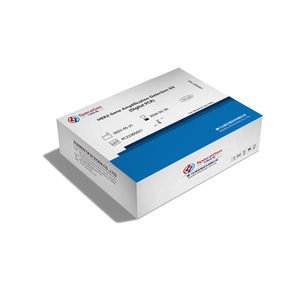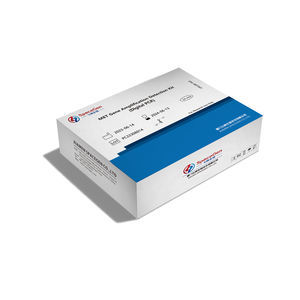

- Company
- Products
- Catalogs
- News & Trends
- Exhibitions
Apoptosis detection kit PC219010101oncologyEGFRplasma
Add to favorites
Compare this product
Characteristics
- Application field
- apoptosis, oncology
- Tested parameter
- EGFR
- Sample type
- plasma, cell, tissue
- Analysis mode
- molecular
Description
Epidermal growth factor receptor (EGFR) is a receptor tyrosine kinase, expressed in 50% of non-small cell lung cancer (NSCLC) [1], which is closely related to the occurrence and development of tumors. The carcinogenic mutations of EGFR mostly occur in exons 18-21, of which 19 del and L858R account for 85% to 90% of all EGFR mutations [1], which are also the most common EGFR-TKI sensitive mutations. The T790M mutation suggests resistance to the first and second generation of EGFR-TKIs while sensitive to the third generation of EGFR-TKI. Both the National Comprehensive Cancer Network (NCCN) and the Chinese Society of Clinical Oncology (CSCO) guidelines have included EGFR mutation detection as a category 1 recommendation [2] [3]. The guidelines also clearly stated that "When tumor tissue cannot be obtained or can be obtained for small amounts ,EGFR mutation detection can be performed through peripheral blood /tumor DNA (cf/ctDNA) [3]".
INTRODUCTION OF ctDNA
ctDNA is released into blood vessels by tumor cells or circulating tumor cells through apoptosis, necrosis, phagocytosis, or active secretion. It can reflect the real-time tumor load in the body, dynamically monitor the efficacy of drugs, and predict disease changes early. ctDNA has become a dynamic biomarker based on plasma, which plays an important role in the fields of early tumor diagnosis, molecular typing, targeted drug selection, and monitoring of minimal residual disease. Since the content of ctDNA is usually less than 1% of the total cfDNA of an individual [4], screening ctDNA from a large amount of cfDNA requires high detection sensitivity.
Catalogs
No catalogs are available for this product.
See all of SPACEGEN‘s catalogsRelated Searches
- Assay kit
- Blood assay kit
- Immunoassay assay kit
- Plasma assay kit
- Infectious disease detection kit
- Analysis software
- Molecular test kit
- Respiratory infection test kit
- Whole blood detection kit
- Optical assay kit
- Clinical assay kit
- Fluorescence assay kit
- Viewer software
- Real-time PCR test kit
- Research assay kit
- Laboratory software
- Windows software
- Laboratory detection kit
- Cell assay kit
- Oncology test kit
*Prices are pre-tax. They exclude delivery charges and customs duties and do not include additional charges for installation or activation options. Prices are indicative only and may vary by country, with changes to the cost of raw materials and exchange rates.


